High Impact Tutoring Built By Math Experts
Personalized standards-aligned one-on-one math tutoring for schools and districts
Supplementary angles
Here you will learn about supplementary angles, including how to find missing angles by applying knowledge of supplementary angles.
Students will first learn about supplementary angles as a part of measurement and data in 4th grade. They will expand that knowledge as they progress through middle school.
What are supplementary angles?
Supplementary angles are two angles that add up to 180 degrees. They can be adjacent or not adjacent. Adjacent angles are angles that share a common arm and a vertex.
| Adjacent supplementary angles | Non-adjacent supplementary angles |
|---|---|
 | 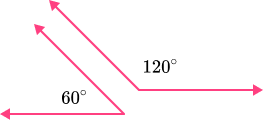 |
Adjacent supplementary angles make a straight line.
You can use what you know about supplementary angles to decompose angles and find the measurement of an unknown angle.
What are supplementary angles?

Common Core State Standards
How does this relate to 4th grade math?
- Grade 4: Measurement and Data (4.MD.C.7)
Recognize angle measure as additive. When an angle is decomposed into non-overlapping parts, the angle measure of the whole is the sum of the angle measures of the parts. Solve addition and subtraction problems to find unknown angles on a diagram in real world and mathematical problems, for example, by using an equation with a symbol for the unknown angle measure.
![[FREE] Angles Worksheet (Grade 4)](https://thirdspacelearning.com/wp-content/uploads/2023/08/Angles-check-for-understanding-quiz-listing-image.png)
[FREE] Angles Worksheet (Grade 4)
![[FREE] Angles Worksheet (Grade 4)](https://thirdspacelearning.com/wp-content/uploads/2023/08/Angles-check-for-understanding-quiz-listing-image.png)
Use this quiz to check your grade 4 students’ understanding of angles. 10+ questions with answers covering a range of 4th grade angles topics to identify areas of strength and support!
DOWNLOAD FREE![[FREE] Angles Worksheet (Grade 4)](https://thirdspacelearning.com/wp-content/uploads/2023/08/Angles-check-for-understanding-quiz-listing-image.png)
[FREE] Angles Worksheet (Grade 4)
![[FREE] Angles Worksheet (Grade 4)](https://thirdspacelearning.com/wp-content/uploads/2023/08/Angles-check-for-understanding-quiz-listing-image.png)
Use this quiz to check your grade 4 students’ understanding of angles. 10+ questions with answers covering a range of 4th grade angles topics to identify areas of strength and support!
DOWNLOAD FREEHow to find the measure of supplementary angles
In order to find the measure of supplementary angles you need to:
- Determine which angles are supplementary.
- Identify given angle measurements and the unknown angle or angles.
- Find the missing angle.
- Clearly state the answer.
Supplementary angles examples
Example 1: finding missing angle measures (adjacent angles)
The two angles shown are supplementary. Find the measure of angle x.
- Determine which angles are supplementary.
The question states that angles x and y are supplementary and equal 180^{\circ}.
x+y=180
2Identify given angle measurements and the unknown angle or angles.
Angle y is 17^{\circ}.
The unknown angle is angle x, and when it’s added to 17^{\circ} will equal 180^{\circ}.
3Find the missing angle.
To find the missing angle, you will subtract 17 from 180.
x=180-17
x = 163
4Clearly state the answer using angle terminology.
The measurement of angle x is 163^{\circ}.
Example 2: finding missing angle measures (adjacent angles)
\angle ABC and \angle CBD are supplementary angles. \angle ABC has a measure of 109^{\circ}. What is the measure of \angle CBD?
Determine which angles are supplementary.
The question states that \angle ABC and \angle CBD are supplementary angles, which means they equal 180 degrees.
\angle A B C + \angle C B D=180^{\circ}
Identify given angle measurements and the unknown angle or angles.
The question states that \angle A B C=109^{\circ}.
\angle CBD is unknown, and can be called x, and when added to 109^{\circ} will equal 180^{\circ}.
109+x=180
Find the missing angle.
In order to find the measure of \angle CBD, you will subtract 109 from 180.
x=180-109
x=71^{\circ}
Clearly state the answer.
The measurement of angle CBD is 71^{\circ}.
Example 3: finding missing angle (non-adjacent angles)
The pair of angles are supplementary. Find the measure of angle F.
Determine which angles are supplementary.
The question states that angles D and F are supplementary and equal 180^{\circ} .
D+F=180
Identify given angle measurements and the unknown angle or angles.
Angle D has a measurement of 21^{\circ}.
The measurement of angle F is unknown, but when added to angle D, will equal 180^{\circ}.
21^{\circ}+F=180^{\circ}
Find the missing angle.
In order to find the measure of the second angle, \angle F, you will subtract 21 from 180.
F=180-21
\angle F=159
Clearly state the answer.
The measurement of \angle F is 159^{\circ}.
Example 4: finding missing angle (not adjacent)
\angle L and \angle M are supplementary angles. \angle M measures at 98^{\circ}. What is the measure of \angle L?
Determine which angles are supplementary.
As stated in the question, \angle L and \angle M are supplementary angles, which means when added together will equal 180^{\circ}.
L + M=180^{\circ}
Identify given angle measurements and the unknown angle or angles.
\angle M measures at 98^{\circ}.
The measurement of angle L is unknown, but when added to \angle M, will equal 180^{\circ}.
L+98^{\circ}=180^{\circ}
Find the missing angle.
You will subtract 98 from 180 to find the measure of \angle L.
L=180-98
L=82^{\circ}
Clearly state the answer.
The measurement of \angle L is 82^{\circ}.
Example 5: finding missing angle (no diagram)
Two angles ‘x and y' are supplementary and one of them is 147^{\circ}. What is the size of the other angle?
Determine which angles are supplementary.
The question states that angles x and y are supplementary angles, meaning when added together they will equal 180^{\circ}.
x+y=180^{\circ}
Identify given angle measurements and the unknown angle or angles.
Because it is not stated which angle is 147 degrees, you can assume that \angle x= 147^{\circ}.
This would mean that \angle y is unknown, but when added to \angle x would equal 180^{\circ}.
147^{\circ}+y=180^{\circ}
Find the missing angle.
You will subtract 147 from 180 to find the measure of \angle y.
y=180-147
y=33^{\circ}
Clearly state the answer.
The measurement of \angle y is 33^{\circ}.
Example 6: finding missing angle
Two angles ‘x and y' are supplementary and one of them is a right angle. What is the size of the other angle?
Determine which angles are supplementary.
The question states that angles x and y are supplementary, meaning when added together they will equal 180^{\circ}.
x+y=180^{\circ}
Identify given angle measurements and the unknown angle or angles.
Because it is not stated which angle is a right angle, you can assume that \angle x is a right angle. A right angle will always measure at 90^{\circ}.
This would mean that \angle y is unknown, but when added to \angle x would equal 180^{\circ}.
90^{\circ}+y=180^{\circ}
Find the missing angle.
You will subtract 90 from 180 to find the measure of \angle y.
y=180-90
y=90^{\circ}
Clearly state the answer.
The measurement of \angle y is 90^{\circ}. \; \angle y is also a right angle.
Teaching tips for supplementary angles
- Rather than having students practice finding and decomposing supplementary angles on multiple skill worksheets, provide them with a variety of practice problems, activities, and/or projects that have a real-world context. This will deepen their understanding of this skill.
Easy mistakes to make
- Mixing up supplementary angles and complementary angles
Students may mix up supplementary and complementary angles, thinking that complementary angles sum to 180^{\circ} and that supplementary angles sum to 90^{\circ}. However, complementary angles have a sum of 90^{\circ} and supplementary angles have a sum of 180^{\circ}.
- Assuming supplementary angles must have a common vertex
Supplementary angles can be either adjacent or not adjacent. Not adjacent supplementary angles do not share a common vertex, but their angles will still add up to 180^{\circ}.
Practice supplementary angles questions
1. The two angles shown are supplementary. Find the measure of \angle pmn.
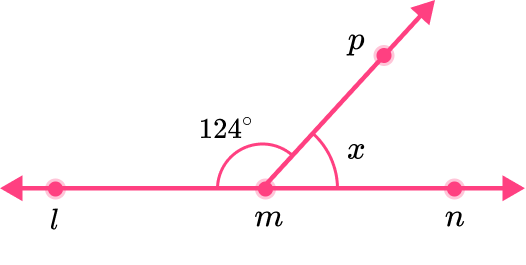




The two angles are supplementary, so they must have a sum of 180.
You will subtract 124 from 180 to find the measure of the missing angle.
x=180-124
x=56
The missing angle measures at 56^{\circ}.
2. The two angles shown are supplementary. Which of the following could be the measure of \angle srt?
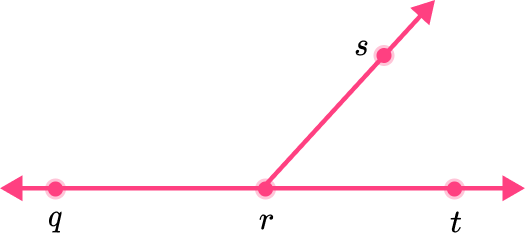




\angle srt is an acute angle, which means that it’s measurement is less than 90^{\circ}.
An angle with the measure of 114^{\circ} would be an obtuse angle. \angle srt can not equal 114^{\circ}.
An angle with the measure of 90^{\circ} would be a right angle. \angle srt is not a right angle.
An angle with the measure of 10^{\circ} would be an acute angle, however, it would be a very skinny acute angle. \angle srt is too large to equal 10^{\circ}.
\angle srt is an acute angle, with a measurement of 45^{\circ}.
2. \angle a and \angle b are supplementary angles. \angle a measures at 14^{\circ}. What is the measure of \angle b?
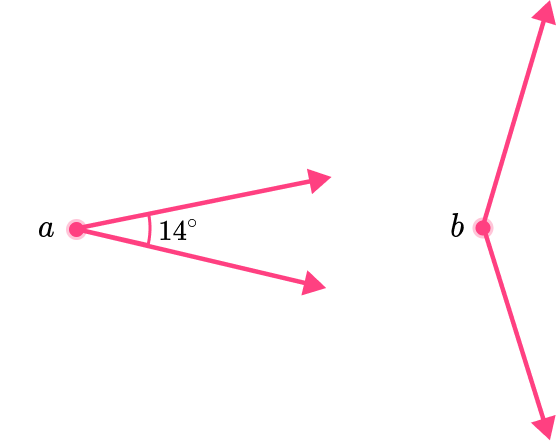




The two angles are supplementary, so they must have a sum of 180.
You will subtract 14 from 180 to find the measure of the missing angle.
b=180-14
b=166
The missing angle measures at 166^{\circ}.
4. \angle f and \angle g are supplementary angles. \angle f measures at 113^{\circ}. What is the measure of \angle g?
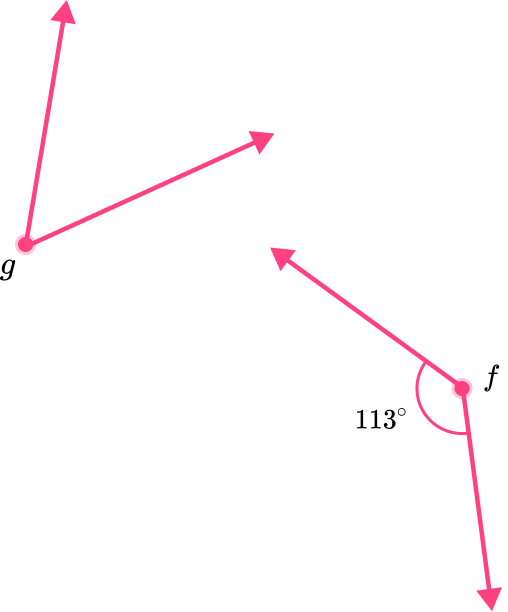




The two angles are supplementary, so they must have a sum of 180.
You will subtract 113 from 180 to find the measure of the missing angle.
g=180-113
g=67
The missing angle measures at 67^{\circ}.
5. Two angles 'x and y' are supplementary and one of them is 47^{\circ}. What is the size of the other angle?




The two angles are supplementary, so they must have a sum of 180.
You will subtract 47 from 180 to find the measure of the missing angle.
x=180-47
x=133
The missing angle measures at 133^{\circ}.
6. Two angles 'x and y' are supplementary and one of them is 123^{\circ}. What is the size of the other angle?




The two angles are supplementary, so they must have a sum of 180.
To find the measure of the missing angle, you can subtract 123 from 180.
x=180-123
x=57
The missing angle measures at 57^{\circ}.
Supplementary angles FAQs
Supplementary angles add up to 180 degrees, or a straight angle.
Complementary angles add up to 90 degrees, or a right angle.
No, three angles will never be supplementary, even if the sum of their measurement is 180^{\circ}. Supplementary angles will only occur in pairs.
\angle a + \angle b = 180^{\circ}; two angles are supplementary if angle \; a and angle \; b equal 180^{\circ}.
The next lessons are
Still stuck?
At Third Space Learning, we specialize in helping teachers and school leaders to provide personalized math support for more of their students through high-quality, online one-on-one math tutoring delivered by subject experts.
Each week, our tutors support thousands of students who are at risk of not meeting their grade-level expectations, and help accelerate their progress and boost their confidence.

Find out how we can help your students achieve success with our math tutoring programs.
[FREE] Common Core Practice Tests (3rd to 8th Grade)
Prepare for math tests in your state with these 3rd Grade to 8th Grade practice assessments for Common Core and state equivalents.
Get your 6 multiple choice practice tests with detailed answers to support test prep, created by US math teachers for US math teachers!